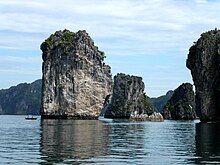Đông Bắc Bộ
Đông Bắc Bộ ( Vietnamese for Northeast ) is a region of a Vietnam . The region is a geographical part of northern Vietnam ( Bắc Bộ ), which also includes the Northwest regions ( Tây Bắc Bộ ) and the Red River Delta ( Đồng Bằng Sông Hồng ).
Provinces
| Provinces | Capital | Population ( census of April 1, 2009) | Area (km²) |
|---|---|---|---|
| Bắc Giang | Bắc Giang | 1,594,300 | 3,827.4 km² |
| Bắc Kạn | Bắc Kạn | 301,500 | 4,868.4 km² |
| Cao B .ng | Cao B .ng | 518,900 | 6,724.6 km² |
| Ha Giang | Ha Giang | 683,500 | 7,945.8 km² |
| Lạng Sơn | Lang Sơn | 746,400 | 8,331.2 km² |
| Phu Thọ | Việt Trì | 1,336,600 | 3,528.4 km² |
| Quảng Ninh | Hạ Long | 1,091,300 | 6,099.0 km² |
| Thái Nguyên | Thái Nguyên | 1,127,200 | 3,546.6 km² |
| Tuyên Quang | Tuyên Quang | 723,300 | 5,870.4 km² |
geography
The region is mainly characterized by the alpine character, the soil of which is often calcareous . The western part of the region is bounded by the Red River , where sediment deposits such as granite , slate and limestone occur upstream . This is how the Yunnan-Guizhou Plateau to the west came into being . Most of the high mountains are mainly concentrated in the northeast region, for example the Tây Côn Lĩnh and Kiêu Liêu Ti mountains. The boundary between the northeast and northwest regions is controversial among geographers, as either the Red River or the Hoàng Liên Sơn Mountains are located there. The north is bounded by the People's Republic of China . The Gulf of Tonkin is located southeast of the region and the Tam Đảo and the Red River Delta to the south .
The People's Republic of China and the north-east region of Vietnam share a common border, which is mainly characterized by plateaus, which are named as follows from west to east: Bắc Hà plateau, Quản Bạ plateau and the karst plateau Đồng Văn . The average height of the plateaus is around 1000–1200 m. The highest plateau is the Đồng Văn karst plateau with a height of 1600 m. Since this karst plateau corresponds to a karst hydrological system, it is called a fluviokarst . A fluviokarst can in many cases also be a fully developed karst, but here there are additional fluvial forms, often as large gorges or ravines , which arise allochthonously in other geological formations. Furthermore, there are also some levels near this boundary, for example the Thất Khê level , Lạng Sơn level , Lộc Bình level and the Cao Bằng level .
East of the Northeast Region are several low arc-shaped elevations, which are reflected in the order from east to west: the anticline Sông GAM , the mountain Ngân Sơn-Yên Lạc , the massif Bắc Sơn and the mountains Đông Trieu , which affects the landscape shape the Halong Bay . In the southwest of the region are the provinces Phú Thọ , Tuyên Quang , Yên Bái and Bắc Giang in the low-lying plains, which are about 100-150 m high.
The river system in the northeast region is widely ramified. The following rivers flow through this region: the Red River, the Chảy , the Lô , the Gâm , the Cầu , the Thương , the Lục Nam , the Bằng Giang , the Bắc Giang , the Kỳ Cùng and many more. The adjacent South China Sea contains about two thirds of the islands of Vietnam, e.g. B. Cát Bà , Hòn Bà , Hòn Mê , Hòn Ngư etc.
geology
The northeast region arose around 600 million years ago in the Ediacarian . The alternating regression and transgression of the coastline in the course of the Alpidic orogeny led, according to the Wilson cycle, to the fact that the ocean basin is completely closed and the (alpinotype) mountain formation reaches its peak ( Himalayan stage ). The thrust tectonics has led to an enormous thickening of the earth's crust involved. The thickened crust area is lifted out a little by mass balancing movements and a high mountain range is created. The continental blocks, which were previously separated by the ocean basin, are now united to form a larger continental block (large or supercontinent).
climate
Although the northeast region is in the east side climate, but has extensive terrain with high mountains, the winter monsoon means that the air masses are forced to flow over a mountain range and thus a catabatic fall wind usually occurs on the lee side . The summers are also quite cool, so that the region has more moderate climatic characteristics. In the provinces of Lào Cai, Hà Giang, Cao Bằng and Lạng Sơn, temperatures down to 0 ° C can prevail after the snowfall limit has been exceeded .
Individual evidence
- ↑ Lê Bá Thảo (Ed.): Thiên nhiên Việt Nam . Nhà xuất bản Giáo dục, 2009, p. 29-30 (Vietnamese).
- ↑ Lê Bá Thảo (Ed.): Thiên nhiên Việt Nam . Nhà xuất bản Giáo dục, 2009, p. 36 (Vietnamese).
- ↑ Lê Bá Thảo (Ed.): Thiên nhiên Việt Nam . Nhà xuất bản Giáo dục, 2009, p. 58 (Vietnamese).
- ↑ Lê Bá Thảo (Ed.): Thiên nhiên Việt Nam . Nhà xuất bản Giáo dục, 2009, p. 30 (Vietnamese).
- ↑ Lê Bá Thảo (Ed.): Thiên nhiên Việt Nam . Nhà xuất bản Giáo dục, 2009, p. 31 (Vietnamese).
- ↑ Lê Bá Thảo (Ed.): Thiên nhiên Việt Nam . Nhà xuất bản Giáo dục, 2009, p. 31-32 (Vietnamese).
- ↑ THIÊN NHIÊN PHÂN HÓA ĐA DẠNG. toiyeudialy.blogspot.de, accessed on November 11, 2016 (Vietnamese).
Coordinates: 21 ° 27 ' N , 106 ° 8' E


